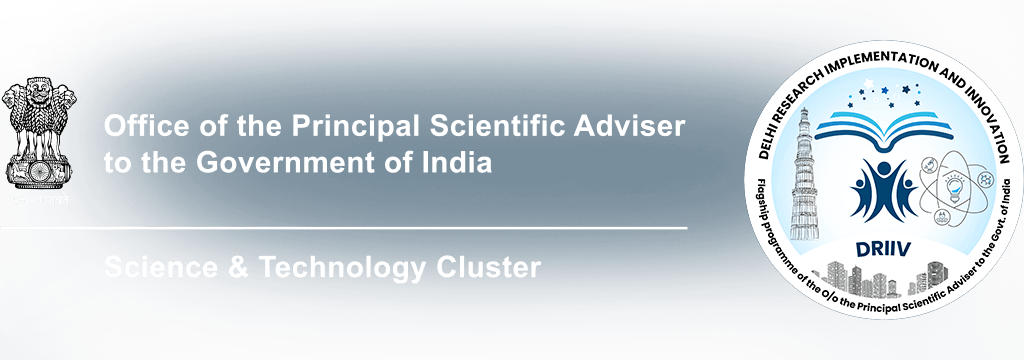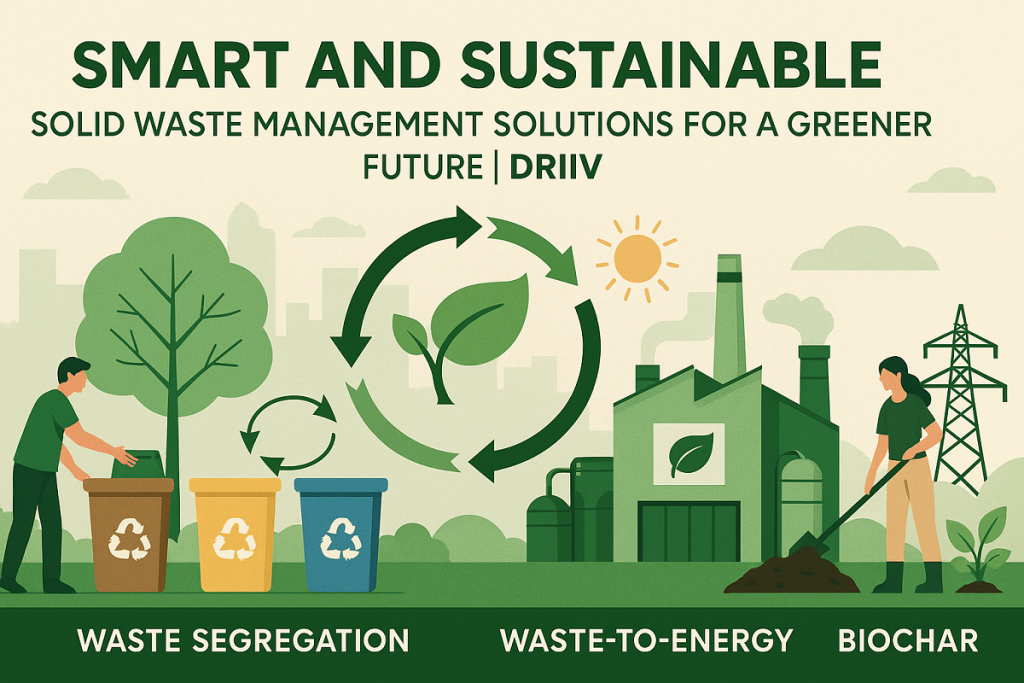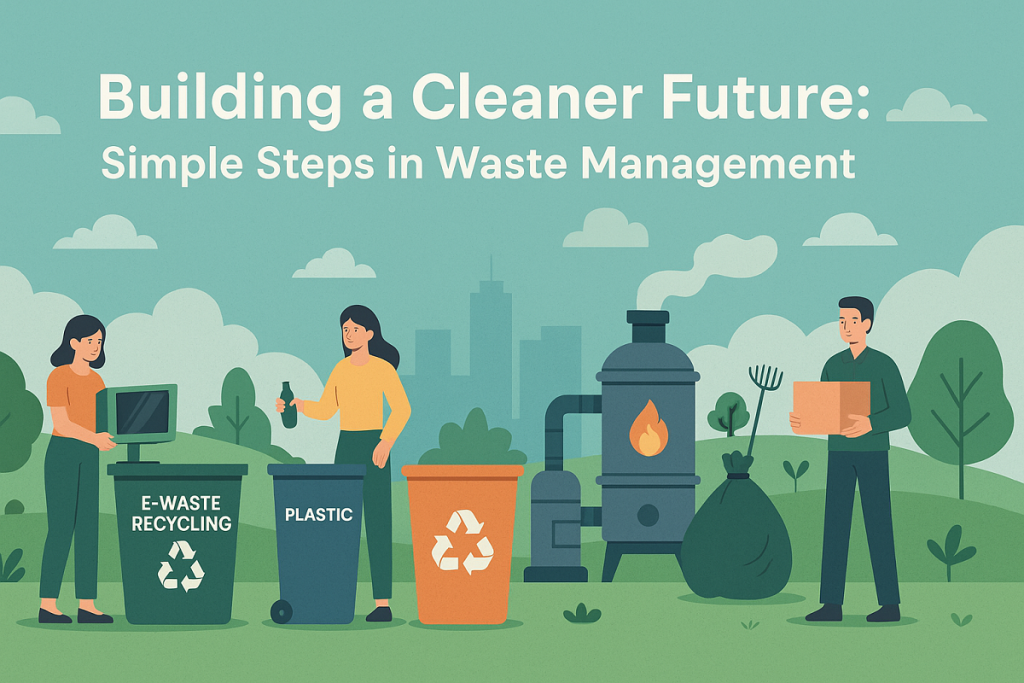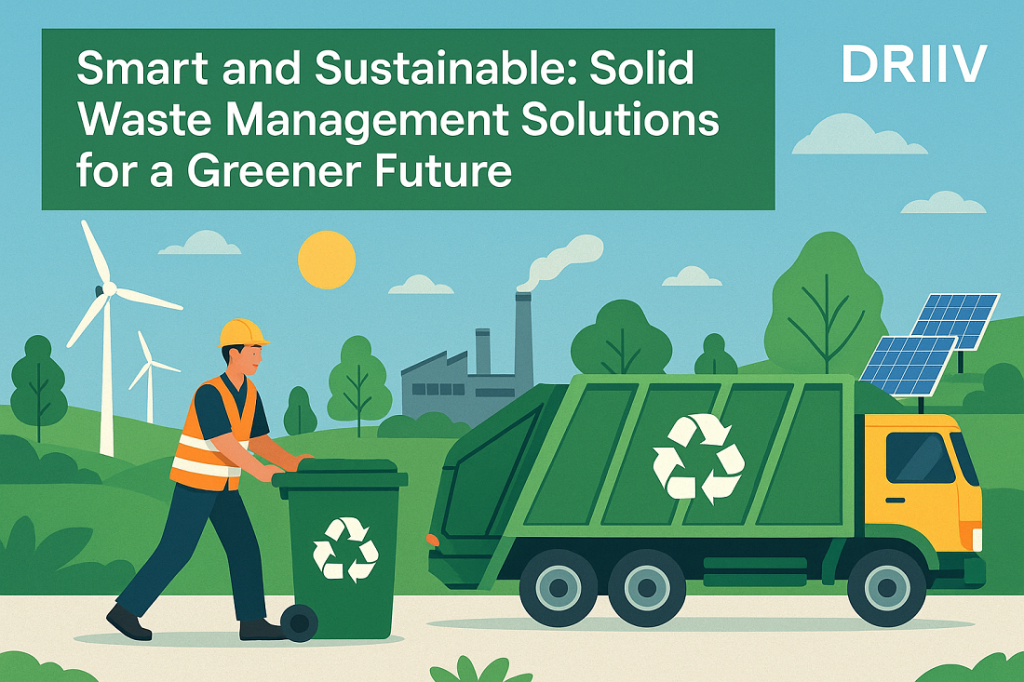Introduction
India generates millions of tonnes of solid waste every year. With rapid urbanization, population growth, and increasing consumption, managing this waste has become a major environmental challenge. Without proper disposal, waste leads to pollution, health risks, and degradation of natural resources. That’s why solid waste management solutions are now more important than ever.
At DRIIV, we are dedicated to building innovative and sustainable systems to deal with waste effectively. We believe that the future lies in adopting new technologies, promoting the circular economy, and turning waste into resources. In this blog, we will explore practical solutions like waste to energy, waste segregation, biochar, and more that can transform how India handles its waste.
Understanding Solid Waste in India
India produces more than 62 million tonnes of municipal solid waste (MSW) every year, according to CPCB (Central Pollution Control Board). Out of this, only a fraction is treated scientifically.
Main Types of Waste:
- Organic waste (food, garden)
- Plastic waste
- Biomedical waste
- E-waste
- Construction and demolition waste
Without proper segregation and treatment, all types of waste end up in landfills, causing soil, air, and water pollution. The solution? Smart and sustainable solid waste management solutions.
DRIIV’s Approach to Solid Waste Management
DRIIV (Delhi Research Implementation and Innovation) Cluster, backed by the Office of the Principal Scientific Adviser to the Government of India, focuses on solving real-world challenges through innovation. Solid waste management is one of our top priorities, and we follow these key principles:
- Waste Segregation at Source
- Conversion of Waste to Energy
- Promotion of Circular Economy
- Biochar Production
- Community Engagement & Awareness
- Let’s understand each of these solutions in detail.
1. Waste Segregation: The First Step
The first step toward proper waste management is waste segregation — separating wet, dry, and hazardous waste at the source (homes, offices, etc.).
- Why is Waste Segregation important?
- Makes recycling and reuse easier
- Reduces landfill load
- Improves efficiency of waste treatment plants
- Helps recover valuable resources
DRIIV supports technology-based waste collection systems that use color-coded bins, smart sensors, and digital tracking to improve segregation practices across communities.
2. Waste to Energy: Turning Trash into Power
Waste to energy (WTE) is a promising solution that helps in disposing of waste and generating electricity or fuel from it.
What is Waste to Energy Technology?
It refers to various technologies that convert non-recyclable waste into usable energy — such as electricity, heat, or gas.
Popular Waste to Energy Technologies:
- Incineration: Burning waste to produce heat or electricity
- Anaerobic digestion: Breaking down organic waste in the absence of oxygen to produce biogas
- Gasification & pyrolysis: Thermal treatment of waste to generate gas, oil, or char
At DRIIV, we promote WTE plants that follow eco-friendly practices and minimize harmful emissions. These plants can significantly reduce the burden on landfills and help cities become energy self-sufficient.
3. Biochar: Sustainable Use of Organic Waste
Biochar is a charcoal-like substance made from biomass (agricultural and organic waste) through a process called pyrolysis.
Benefits of Biochar:
- Improves soil fertility
- Retains water in soil
- Captures and stores carbon (climate-friendly)
- Reduces greenhouse gas emissions
DRIIV encourages the production of biochar in rural areas using small-scale pyrolysis units. This not only manages organic waste but also supports farmers by improving soil quality.
4. Circular Economy: Redefining Waste as Resource
Traditional waste management follows a linear approach: Take → Use → Dispose. But the circular economy model is different.
What is Circular Economy?
It is a system where products and materials are reused, repaired, recycled, and regenerated to minimize waste.
Circular Economy in Waste Management:
- Composting kitchen waste into organic fertilizer
- Recycling plastics into new products
- Upcycling old clothes, e-waste, etc.
DRIIV’s mission is to transform Indian cities into circular economy hubs by supporting green startups, eco-friendly innovations, and sustainable product design.
5. Community Engagement: Awareness Is Power
Technology alone cannot solve the waste crisis. People must participate.
At DRIIV, we:
- Organize workshops in schools and communities
- Train municipal workers and local bodies
- Develop digital awareness tools and campaigns
- Promote citizen-led composting and waste audits
- Behavioral change is key to the success of any solid waste management solution.
Key Technologies Supported by DRIIV
Technology Purpose
Smart bins: Automated waste segregation
Bio-methanation: Biogas from food waste
Composting units: Organic fertilizer from wet waste
Plastic shredders: Recycled plastic products
Decentralized WTE plants: Local power from waste
These technologies are low-cost, scalable, and suitable for urban and rural areas.
Government Policies Supporting Waste to Energy and Circular Economy
India has several government schemes to boost waste management and green energy:
- Swachh Bharat Mission
- Smart Cities Mission
- Waste to Energy Program (MNRE)
- GOBAR-Dhan Scheme for rural bio-waste
- National Bio-Energy Mission
DRIIV collaborates with government bodies and private stakeholders to ensure smooth implementation of these policies with real-world impact.
Challenges in Waste Management
While the technology and policies exist, there are challenges:
- Lack of awareness and participation
- Unsegregated waste collection
- Inefficient transport systems
- Shortage of trained manpower
- Need for more WTE infrastructure
DRIIV is working to overcome these issues by:
- Piloting new models
- Supporting startups
- Building public-private partnerships
Future Vision of DRIIV
By 2030, DRIIV aims to:
- Reduce landfill waste by 60%
- Ensure 100% waste segregation in all clusters
- Promote at least 50 new circular economy startups
- Deploy decentralized waste to energy technology in every city
- Scale biochar use for sustainable farming
Conclusion
Solid waste management solutions are essential for building a cleaner, greener India. Through technology, awareness, and collaboration, we can turn waste into a valuable resource and drive environmental change.
At DRIIV, we are committed to implementing innovative approaches like waste to energy, biochar production, waste segregation, and promoting a circular economy that benefits both people and the planet.
Let’s work together to close the loop and move towards a zero-waste future.
FAQs
1. What is the best way to manage solid waste in cities?
The best approach combines waste segregation at source, waste to energy technology, recycling, and community awareness. It should follow the Reduce-Reuse-Recycle model.
2. How does waste to energy work?
Waste to energy (WTE) uses methods like incineration, anaerobic digestion, or gasification to convert waste into electricity, heat, or fuel.
3. What is the role of biochar in waste management?
Biochar is produced by burning organic waste in limited oxygen. It is used as a soil amendment and helps in carbon capture, making it a climate-friendly solution.
4. How does DRIIV support the circular economy?
DRIIV supports green startups, pilot projects, and collaborations that focus on recycling, reuse, and turning waste into value-added products, aligning with circular economy goals.
5. What is waste segregation and why is it important?
Waste segregation is the practice of separating waste into categories like wet, dry, and hazardous. It makes recycling and treatment more effective and reduces the burden on landfills.
Let us know how DRIIV can help your city or industry adopt modern solid waste management solutions. Together, we can create a clean and sustainable India!




